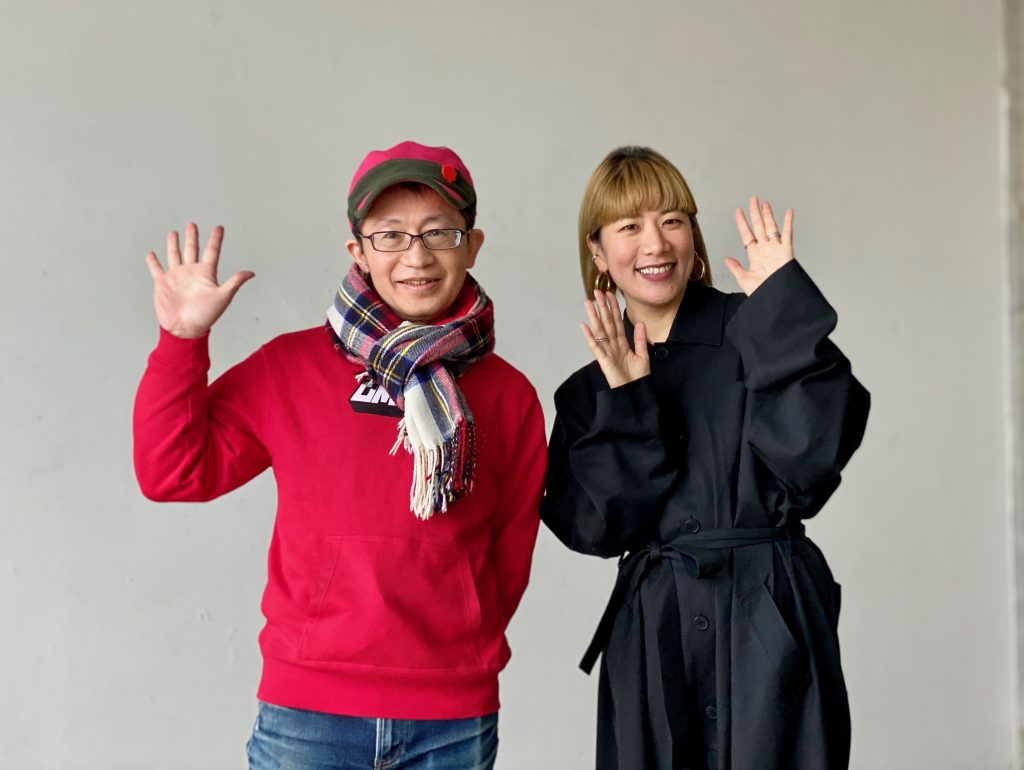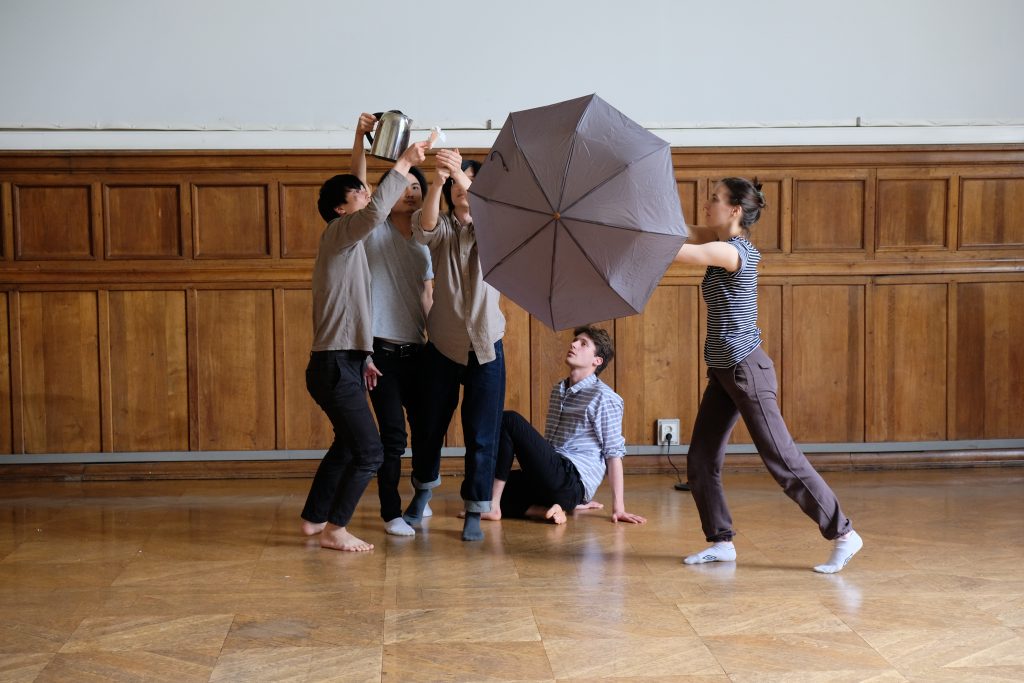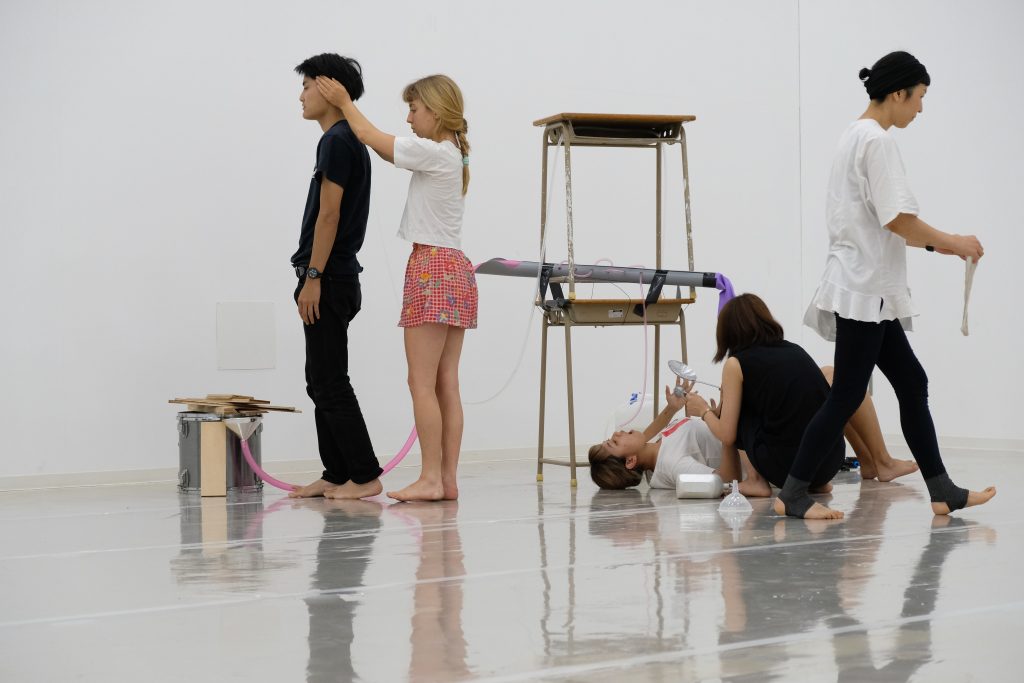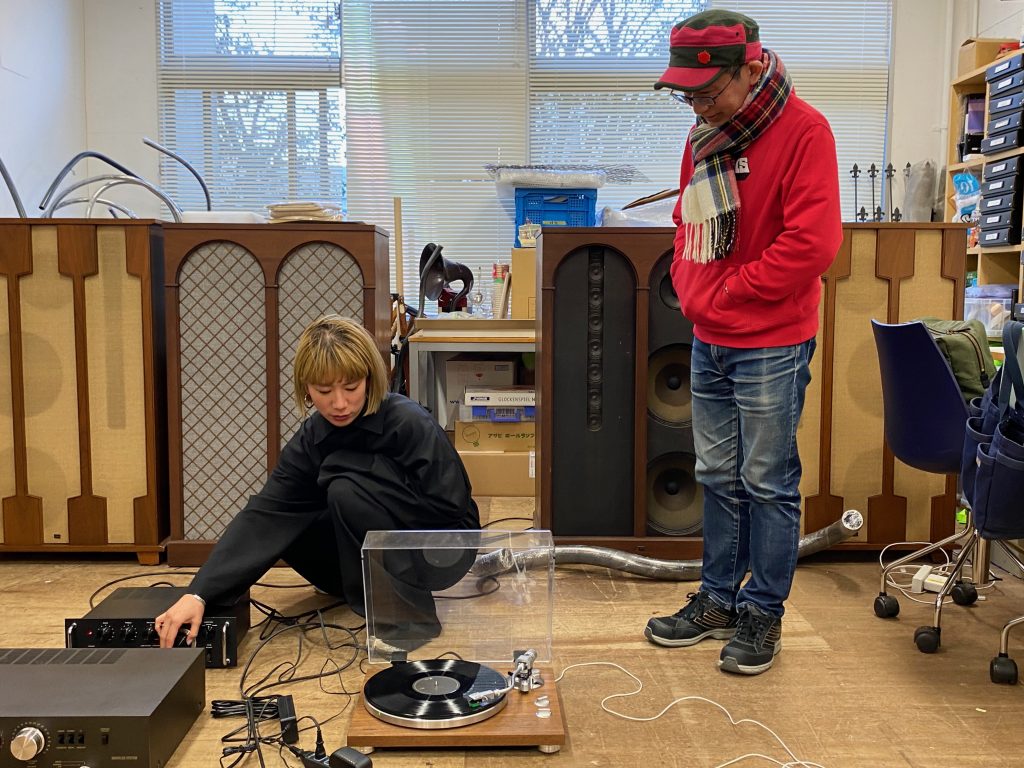SATO Emi
This is a series introducing the current state of media art in Japan from the perspective of schools through discussions with university faculty. File 3 will feature Tokyo University of the Arts. Since its establishment in 1887 as the Tokyo Fine Arts School, it has been laying the foundation for artistic culture for over 130 years. Within its long history, there have been relatively recent developments. The Department of Intermedia Art was founded in the Faculty of Fine Arts in 1999, and the Global Art Practice was established in the Graduate School of Fine Arts in 2016. We spoke with the respective faculty members in charge, HACHIYA Kazuhiko and MOHRI Yuko.

—At Tokyo University of the Arts (referred to as Geidai), there are no departments or majors specifically named “Media” or “Information.” How, then, is media art taught at Geidai?
HACHIYA The Department of Intermedia Art (referred to as Sentan) was established to break free from specific fields such as existing painting or sculpture departments and to embrace a wide range of disciplines. Consequently, at the undergraduate level, we cover a variety of subjects. Classes encompass photography, sculpture, electronic work, film, performing arts, and more. I am in charge of the electronic work class and also give lectures introducing the history of media art. However, I don't focus on specifically teaching media art. While I hold the title of “media artist,” my goal isn’t necessarily to have students become media artists. Ms. MOHRI also creates works with a media art flavor, but your title is different.
MOHRI I use the title of “artist.” After graduating from the Department of Information Design at Tama Art University (referred to as Tamabi), I entered the Sentan program at the Graduate School in 2004. During my undergraduate years, I acquired technical skills in sound art and kinetic art. When I wanted to further my studies, I chose Sentan because it had various specialized professors and students in performing arts and visual arts. I heard rumors that it offered the opportunity to study and engage in discussions across different fields. Although my student days were about 20 years ago, I believe the broad framework remains largely unchanged.
HACHIYA The Intermedia Art major in the graduate program was established in 2003, so Ms. MOHRI, you were part of the second cohort? When Sentan was founded in 1999, I wasn’t a faculty member at the time, but it seems that teachers were gathered by restructuring existing departments. It wasn't necessarily focused on media art at the beginning. I often say, “Sentan is, in other words, the department of ‘miscellaneous.’”
MOHRI I enrolled at Tamabi in 2000, a time when information design departments were being newly established at various universities. In the long history of Geidai, Sentan was a new department since the establishment of the Department of Design in 1975. Other institutions like Musashino Art University’s Department of Design Informatics and the Institute of Advanced Media Arts and Sciences [IAMAS] were also established around the year 2000. Looking back on my student days, even though terms like “media” or “information” were used, each university seemed to be exploring what kind of art and design could be studied within those categories and what could be achieved in these new genres.
—For students who want to pursue media art, do you mean that you respond to their requests through individual laboratories?
HACHIYA Well, yes. However, in my laboratory, there are students who create works with computers, but there are also those who draw manga or animation. At the undergraduate level, the style is more about trying various things and finding what suits oneself, so I don’t have a specific teaching approach that narrows things down too much.
MOHRI Not limited to Japan, there has been an increase in artists dealing with “new media” over the past 20 years. The term “new media” itself may already sound outdated, but it refers to new mediums that came after traditional photography, such as video and sound. Nowadays, encountering video works in contemporary art exhibitions is common, but this wasn’t the case in the past.
In the 2000s, departments offering the creation of video works became a distinctive feature, attracting students who were interested and curious. However, today’s university students belong to a generation that has had smartphones since childhood and can create videos without formal instruction. Twenty years ago, there was still a prevailing sentiment of “women doing electronic work?” Akihabara was a predominantly male town, and I even had an experience where, when I tried to buy a soldering iron at an electronics store, I was told, “We don’t sell soldering irons for stained glass classes.” As education in art has changed in parallel with these shifts in societal attitudes, there is a growing need to teach philosophy rather than methodology.
HACHIYA There is a growing trend among students to naturally incorporate electronic devices into their own creations. Recently, a student of a Japanese Painting course consulted me about integrating VR into their work. I believe this integration is healthy and positive. We don’t exclusively admit media art students, and we make an effort to respond to technical inquiries from students in other laboratories or disciplines. Geidai has a collaborative approach to nurturing students, involving everyone in the process.

—To teach philosophical aspects rather than methods, what kind of courses do you offer?
MOHRI I work in the Global Art Practice, a graduate program that is newer than Sentan, which accepts applicants in English. About two-thirds of the students are of foreign nationality. The major covers various genres, aiming to broaden the perspective globally, sharing and contemplating contemporary expressive activities. As instructors, we share our attitudes and approaches to expression with students rather than focusing on teaching methodologies.
For example, there was a student who expressed a desire to “incorporate sound into sculpture.” When it comes to the elements of sound, the possibilities are endless. So, we began the discussion with the question, “Why do you want to produce sound in the first place?” As we delved into the conversation, it emerged that perhaps the student’s goal could be achieved through body expression rather than sound. We then discussed examples of works, such as videos created by Dumb Type, and explored the idea together. In the process, the student shifted towards more concrete discussions, expressing, “It’s fascinating, but considering the era we live in now, I want to create works like this.” These kinds of discussions, building upon such experiences, make up the majority of tutorial-style classes.
I also conduct workshops. When ideas aren’t coming easily, I often say, “Let’s start by moving our bodies,” and I use a method called “Contact Improvisation,” an improvisational performance technique. Since we have students from different genres and countries, the common ground is the body. In this exercise, one student, A, comes up with a movement, and then the next student, B, can either imitate that movement or do something completely different. This process repeats. Some students may find it challenging, while others find it interesting, but the key is to try it out first and then discuss. It’s essentially a negotiation. Instead of unilaterally determining answers, we guide each other to conclusions through mutual adjustment.



HACHIYA While there may be some differences between undergraduate and graduate students, one of Geidai’s missions is to produce excellent artists. However, defining what makes a good artist can be subject to various interpretations. Art is challenging to teach. We can convey techniques and history, but we can’t directly instruct on how to become a good artist. Therefore, rather than actively aiming to mold individuals into a certain type of person, our mission as educators is to recognize and extend each person’s strengths while enabling them to pursue the activities they want to do. I believe students can choose careers outside of art, and I haven’t consciously focused on nurturing media artists.
MOHRI Nowadays, there may be fewer people identifying themselves as “media artists.”
HACHIYA I often say that “media art has dissolved.” What I mean by that is that it has blended into conventional art, spreading and becoming less distinct. I believe it’s okay for the term itself to fade away. Artists are free to create anything. I’m thinking with such a broad perspective.
—In a certain era, there was significance in rallying under the banner of the term “media art,” but it seems like that sense is fading away.
MOHRI There is a sense of transition. Originally, I think every artist considers the idea of wanting to challenge something new as part of their expression. So, at a turning point in an era where it seemed like there was no space left for new challenges, shiny names like “media art” emerged, suggesting, “Maybe something can be done here.” It might have been necessary to have a new name to challenge a new genre. Now, with the changing times, devices have become integrated into society.
HACHIYA Nowadays, using technology doesn’t necessarily require self-consciousness.
MOHRI Artists experimenting with video and sound have increased even more than before, and it has become commonplace as a form of artistic expression. Earlier, Mr. HACHIYA mentioned it “dissolved,” and that’s quite fitting.
—Japan Media Arts Festival concluded in its 25th edition in the fiscal year 2022. How do you perceive art based on technology? It seems like a turning point.
HACHIYA Witnessing the unexpectedly high number of people opposing the end of the Media Arts Festival made me realize how beloved it was as an art festival.
MOHRI I think it was unique, not limited to just media art—whether it’s reading manga or watching the latest anime. You wouldn’t find an art festival like this in other countries.
HACHIYA I have been involved as a behind-the-scenes figure, serving as a judge for the Media Arts Festival’s Art Division and other roles. Both the judging process and the exhibition entail extensive workloads, and I’ve seen the Agency for Cultural Affairs and stakeholders invest considerable resources. However, resources, including budgets, are always limited, and it’s not possible to sustain every initiative indefinitely. After 25 years, reassessing and concluding the festival is, in a way, a natural occurrence. Personally, I believe it’s important to allocate these resources to areas that will become increasingly significant in the future, such as archiving manga, anime, and games. Without doing so, our culture may dissipate, and it’s already happening to some extent. Lately, I’ve developed an interest in retro games and visit used game stores. Foreigners are buying up old software enthusiastically. On the flip side, the creators who contributed to the golden age of such cultures, which are now gaining global attention, are aging or passing away. I think it’s crucial to properly reevaluate players who shaped Japan’s content golden age and archive and preserve manga original artwork, old game consoles, and similar items as part of our culture.
MOHRI Indeed, by properly preserving the archives of content that will support Japan in the future, it can become research material that transcends countries and eras.
HACHIYA For example, if someone from overseas wants to study games, there are very few places they can visit. While there are a few museums for manga, they are limited to partial collections based on eras, authors, and other factors. Without museums that comprehensively cover works and materials in a particular field, such as the Sukagawa Tokusatsu Archives Center, materials can be dispersed, discarded, and lost. On the other hand, media art can be kept in museums. Your works, Ms. MOHRI, are also part of museum collections.
MOHRI In museums, research on the preservation, restoration, and documentation of various media has advanced. Compared to subcultures, media art has been maintained and archived as works of art.
HACHIYA However, the fact that the Media Arts Festival was a competition might have served as a platform for recognizing emerging artists across all genres. What’s truly unfortunate may be the loss of that function. MOHRI For students, receiving an award can be a goal, so its absence could be significant. However, speaking specifically about the art world, there are other awards and grant systems that don’t impose restrictions on medium or size, and more of them are accepting media art.
HACHIYA Kazuhiko
HACHIYA is a media artist and a professor in the Department of Intermedia Art, Faculty of Fine Arts, Tokyo University of the Arts. Born in 1966 in Saga Prefecture. After graduating from Kyushu Institute of Design (now School of Design, Kyushu University), HACHIYA worked at a consulting company before founding PetWORKs Co., Ltd. His notable works include “Inter Dis-Communication Machine” (1993) and “Seeing Is Believing” (1996). He also initiated the “OpenSky” project (2003–), where he prototyped and flew an aircraft inspired by the flying machine in MIYAZAKI Hayao’s Nausicaä of the Valley of the Wind (1984). HACHIYA developed the email software “PostPet.” Recent solo exhibitions include “‘M-02J’ and ‘HK1’ – Fascinated by Tailless Aircraft” (Aichi Museum of Flight, 2022). He also produced an exhibition titled “HomemadeCAVE #3 Portalgraph showcase” (GINZA SIX, 2022), among others.
MOHRI Yuko
MOHRI is an artist and an associate professor in the Global Art Practice, Graduate School of Fine Arts, Tokyo University of the Arts. Born in 1980 in Kanagawa Prefecture. She completed her studies in the Department of Intermedia Art at the Graduate School of Fine Arts, Tokyo University of the Arts. MOHRI creates installations and sculptures that focus on “events” that change based on various conditions such as the environment, rather than approaching composition in a constructive manner. Some of her recent solo exhibitions include “Neue Fruchtige Tanzmusik” (Yutaka Kikutake Gallery, Tokyo, 2022), “I/O” (Atelier Nord, Oslo, 2021), and “Parade (a Drip, a Drop, the End of the Tale)” (Japan House São Paulo, 2021). She has also participated in notable group exhibitions such as the 23rd Biennale of Sydney (Sydney, 2022) and the 34th Bienal de São Paulo (São Paulo, 2021).
*Conversation date: January 25, 2023
>File 3. Tokyo University of the Arts: HACHIYA Kazuhiko×MOHRI Yuko [Part 2]